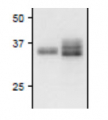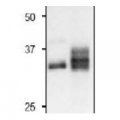1
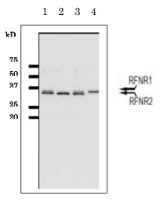
Anti-FNR | Ferredoxin NADP Reductase (root)
- Product Info
-
Immunogen: Purified full-length, tag cleaved, recombinant maize root FNR (R-FNR), UniProt: Q41736
Host: Rabbit Clonality: Polyclonal Purity: Total IgG. Protein A purified in PBS, 50% glycerol. Filter sterilized. Format: Liquid at 1 mg/ml. Quantity: 100 µg Storage: Store at -20°C; once reconstituted make aliquots to avoid repeated freeze-thaw cycles. Please remember to spin the tubes briefly prior to opening them to avoid any losses that might occur from material adhering to the cap or sides of the tube. Tested applications: ELISA (ELISA), Western blot (WB) Recommended dilution: 1: 1000 - 1: 30 000 (WB) Expected | apparent MW: 36.3 kDa | 35.57 kDa - Reactivity
-
Confirmed reactivity: Arabidopsis thaliana, Triticum aestivum, Secale cereale, Zea mays Predicted reactivity: Species of your interest not listed? Contact us Not reactive in: No confirmed exceptions from predicted reactivity are currently known - Application Examples
-
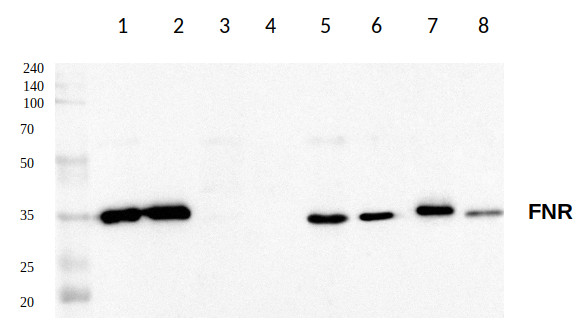
Secale cereale total chloroplast extract (leaves) (1), Triticum aestivum total chloroplast extract (leaves) (2), Triticum aestivum cytosolic protein extract (roots) (3), Secale cereale cytosolic protein extract (roots) (4), Triticum aestivum total protein extract (leaves) (5), Secale cereale total protein extract (leaves) (6), Secale cereale total plastid extract (roots) (7), Secale cereale total protein extract (roots) (8)
15 μg of protein extracted from leaves and roots of Triticum aestivum and Secale cereale were separated on 10% SDS-PAGE and blotted 1h onto nitrocellulose (0.45um) using semi-dry transfer. After blocking with 5% milk in TBST, blots were incubated with the primary antibody at a dilution of 1:5000 in TBST for 1h at room temperature. Following incubation and wash steps, blots were incubated with secondary Goat anti-Rabbit IgG (H&L), HRP conjugated (AS09 602, Agrisera) for 1 hour at a dilution of 1:40 000. Blots were developed with the HRP detection system using Agrisera ECL SuperBright.
Courtesy of Dr Bartosz Szabała,Department of Plant Genetics, Breeding and Biotechnology, Warsaw University of Life Sciences, Poland
Mutant rfnr1 produces R-FNR2 and mutant rfr2 produces R-FNR1.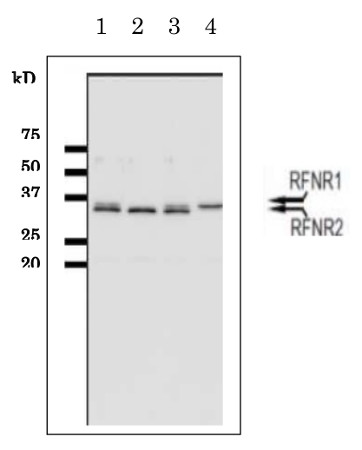
10 μg/well of root total protein of Arabidopsis thaliana wild type leaf (1), (3) and mutants rfer1 (2) and rfnr2-2 (4) grown under 0.2 mM nitrate for 7 days were freshly extracted with 2x SDS-sample buffer (+ 2ME) for SDS-PAGE and denatured with 4X SDS buffer at 95°C for 5 min. Samples were separated on 10% SDS-PAGE and blotted 1h to PVDF membrane. Blot was blocked with 3 % skim milk/TBS-T, 1h/RT with agitation. Blot was incubated in the primary antibody at a dilution of 1: 2000 in TBS-T for 1-2h/RT. The antibody solution was decanted and the blot was washed 4 times for 10 min in TBS-T at RT with agitation. Blot was incubated in matching secondary antibody (anti-rabbit IgG horse radish peroxidase conjugated) diluted to 1:10 000 in for 1h/RT with agitation. The blot was washed as above and developed with a chemiluminescent detection reagent, following manufacture's recommendation.
R-FNR2 is a dominant form in wild type roots. - Additional Information
-
Additional information (application): Antibody will recognize two root FNR proteins (R-FNR1 and R-FNR2) of Arabidopsis thaliana and Zea mays as well as leaf FNRs.
This antibody can be used as a marker of plastids localised in roots. - Background
-
Background: Ferredoxin-NADP reductase (FNR) isoproteins of plant roots play a key role in redox homeostasis of NADPH / NADP + and donation of reducing equivalence to ferredoxin. R-FNR2 is major form of R-FNR and involved in reduction and detoxication of nitrite in root. - Product Citations
-
Selected references: Hachiya et al. (2016). Arabidopsis Root-Type Ferredoxin:NADP(H) Oxidoreductase 2 Is Involved in Detoxification of Nitrite in Roots . Plant Cell Physiol. 57(11):2440-2450. doi: 10.1093/pcp/pcw158.
Hachiya et al. (2016). Arabidopsis Root-Type Ferredoxin:NADP(H) Oxidoreductase 2 Is Involved in Detoxification of Nitrite in Roots. Plant Cell Physiol. 57(11):2440-2450. doi: 10.1093/pcp/pcw158.
Onda et al. (2000). Differential Interaction of Maize Root ferredoxin:NADP(+) Oxidoreductase With Photosynthetic and Non-Photosynthetic Ferredoxin Isoproteins. Plant Physiol. 123(3):1037-45. doi: 10.1104/pp.123.3.1037.
Onda et al. (2000). Differential Interaction of Maize Root ferredoxin:NADP(+) Oxidoreductase With Photosynthetic and Non-Photosynthetic Ferredoxin Isoproteins. Plant Physiol. 123(3):1037-45. doi: 10.1104/pp.123.3.1037. - Protocols
-
Agrisera Western Blot protocol and video tutorials
Protocols to work with plant and algal protein extracts
Agrisera Educational Posters Collection
- Reviews:
-
This product doesn't have any reviews.


